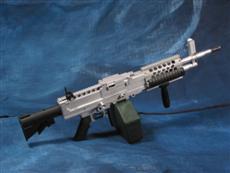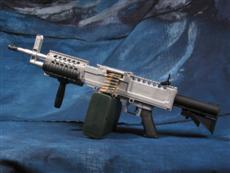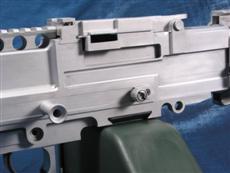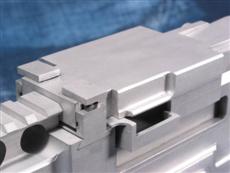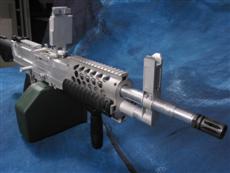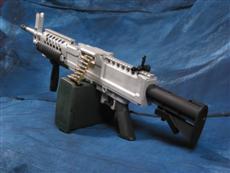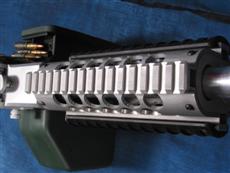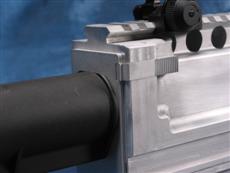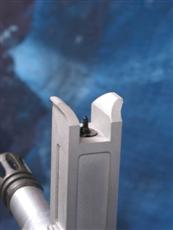The Stoner Rifle, A tale of three weapon systems: When you mention the word "Stoner" to an Airsofter, most of them will look at you, wondering why you have just shouted at them and then reply "Oh you mean the SR-16?" At this point you may see someone in the background chuckling and shaking their head. Okay, so the Knights Armament SR-16, is sort of known as the Stoner Rifle, but in actual fact, it's not THE Stoner Rifle. For that we've got to look back into the depths of time.. meet the Real Stoner... Eugene Stoner was a man with a mission, a weapons designer at heart, he was responsible for a good number of designs that are still on the market. Eugene was responsible for the AR-10, a Space age looking rifle (for the 1950's anyway) chambered for the 7.62 x 51 NATO cartridge which unfortunately missed out on sales due to the dominance of the FN-FAL and the HK G3, in fact some of you might even recognise the AR10.... (is that an SR-25 in your pants or are you happy to see me?). 'Never mind' thought Eugene, and as the world warmed to the lighter 5.56 NATO cartridge, he put the AR10 back on the drawing board, re-chambered it for the lighter smaller cartridge, called it the AR-15 and told the company that he worked for (Armalite) to start selling it. The AR-15 was eventually adopted my the US military (oddly, the Airforce and the Marines first, then the Army) as the M-16, and the rest... well it's history! Eugene didn't rest on his laurels though. By this time, he was already working on a follow-up to the AR-15 - something that would rock the foundations of small unit tactics. But first he produced the AR-7, a survival rifle that could be quickly disassembled and stowed inside a pilots survival pack, this too was taken up by some US military commands. Now the Vietnam war was in full swing, Eugene looked at the lessons learned from the Korean war and decided there was a need for something that fulfilled the needs of a small unit, better then the current combination of assault rifles and machine guns, a force multiplier if you will. Up until now, the main rifle used by American Forces was the M14, essentially a 7.62 version of the venerable WWII vintage M1 Guarand, with the added select fire capability (which was soon deleted as it made the M14 nigh on uncontrollable) However, the M14 was big and bulky, the M16 that was beginning to replace it had the right idea.. light, easy to manoeuvre and easy to control, the "Back Dragon" as the Viet Cong had nicknamed it! Even so, the M16 was found with its 24" tube to be a little bit too long in some situations leading to a range of cut down "Commando" variants. The Aussies that participated in Vietnam had the right idea with their Commonwealth pattern Bren guns. However, it wasn't very versatile - squads that patrolled the Vietnamese rain forest would also have heavier back up such as the M60 "Pig" which frankly was bloody heavy and a pain in the arse to haul around; in fact the M60 was in some ways too good a machine gun, more of a heavy support weapon, than something that could supply organic firepower in a squad. Still, it was used as a close support weapon with some success, and yes, there was the good ol' Ma Deuce M2 .50 cal but that was more of a fixed emplacement machine gun ;) . What was needed was something that could fulfil all the roles of an assault rifle, carbine, light machine gun and heavy machine gun, all rolled into one and at the same time have the ability to change from one to the other with minimum fuss or hassle - a complete "Weapons system". Imagine if you will the following scenario: a squad goes into the boonies, their rifles configured as rifles, one or two in light machine gun format, the squad finds an enemy tunnel system/command village, they reconfigure to carbines and attack, after taking the village, they are tasked with defending it, so they quickly change their rifles into belt fed machine guns and bed down into fixed emplacements, while they wait for reinforcements to be choppered in. Sounds like a dream doesn't it? Not for Eugene Stoner, taking the bull by the horns he developed the ultimate rifle weapon system... the Stoner Rifle Eugene had been working on something for quite some time before this in parallel with the M16, the Stoner 62. However, like the AR-10 it was chambered for the 7.62mm NATO, which was becoming very unfashionable. After a swift redesign, the Stoner 63 was born. Eventually it was adopted in American military speak as the XM22 (or XM23 for the cut down commando version). The Stoner made its debut as the Stoner M63 A1 in early 1963, having won a contract with the US Navy. The Navy looked at the Stoner concept and thought that they could really use it, especially for the highly trained SEAL units that were now heavily involved in the Vietnam conflict. SEAL teams were well funded and highly motivated, and if anyone could use the Stoner to their advantage, it would be them! The M63 was a revelation for SEALS, whole squads were sometimes equipped with M63's giving the lucky SEAL team a disproportionate amount of fire power for their size, equipped as they were with the early precursor to the Beta C-mag, the Stoner "Snail" magazine contained 150 rounds of 5.56 NATO. One well known anecdote about the Stoner/SEAL combination was that if a SEAL patrol was ambushed by the VC, the SEAL team would simply dive for cover and then put down extreme firepower in a 360 degree radius, simply emptying the Stoner magazines into the unseen enemy. With up to four Stoners with snail magazines in each SEAL team, the VC learnt to avoid SEAL patrols, and with such amazing firepower who could blame them! If the enemy were really unlucky one of the Stoners might be carrying one of the special "Soft plastic" magazines, that held even more ammunition! But what made the M63 so special? One of the main things was the fact that it was so light. Compared to the standard machine gun of the period, the M60, the M63 gave away over 10 kilos of weight. In drawn out jungle patrols, weight was life or death, after all, if your machine gun weighed ten kilos less, you could either carry 10 kilos more ammo and pack a bigger wallop, or move over rough terrain ten kilos lighter, and probably survive for longer! In the 1960's this was a complete revelation, "light" support weapons of the time simply did not exist, or were big and unwieldy, for example, the Bren saw service in the Vietnam conflict arming many of the Australian troopers that leant a hand, and it was much lauded by the Americans. So much so, that the M63a1 could be reconfigured into a top magazine loading "Bren" configuration - easy to fire, easy to aim and low to the ground. The only problem, if it could be called a problem, was the fact that the Bren ran off 30 round magazines and was not a belt feed, as such, sustained fire was somewhat lacking. The Stoner sorted this problem out by being belt feed or with its 150 round snail magazine, or it could act as a Bren clone with its own 30 round magazines. Notice above I said "Bren" configuration.. .. and I also said that the M63a1 could be belt fed.... and 30 round Magazine fed? That's where the M63a1 earned its "Weapon System" moniker. Eugene dreamt up a series of innovative quick release catches that meant that a Stoner could be pulled apart and rebuilt into a different type of weapon very quickly with only a minimum number of part. If a trooper wanted a carbine, he could. If he wanted a rifle, he would. If he wanted a heavy machine gun, he did. The NAVY seals loved their Stoners, the USN Biographies and photos concerning that period are littered with references to the Rifle citing its incredible combat effectiveness and the way that it was well ahead of its time, however, not everyone liked this "super weapon". The US Army also decided to trial the Stoner during the Vietnam conflict but they never really got on with it. In the end they cited the fact that it was too complex, too expensive, too hard to maintain, unreliable and prone to malfunction, deciding instead to stay with the M60. If you notice however, many of these same concerns were levelled at the M16 and oddly, these concerns were due to similar reasons. In NAVY SEAL use, the Stoners were treated with due reverence, and were highly appreciated, as such a high level of training was given to the SEAL operatives in the correct maintenance of the M63a1. So much so, contemporary literature records that "SEALS would clean their Stoners so methodically it was almost religious.." or "the SEALS were anally retentive about cleaning the M63a1 and would do so on a daily basis". This was needed as the Stoner was built to extremely high tolerances and was very much a precision built weapon. XM207 US Army Stoner In Army hands however, this did not happen. First of all, there was not an appreciation as to how effective the Stoner could have been - this in turn led to less training, and less cleaning. This was also not helped by the fact that at the time the M16, which had recently been adopted as the standard US battle rifle, was being touted as a "self cleaning rifle" (it wasn't) and was being used with US Army manufactured ammunition that was made from age old (some say it dated from the American Civil war - but more likely the Korean conflict!) artillery gun powder that burnt dirty, therefore slowly leaving dirty barrels and so much fouling that M16s would regularly jam. The Stoner was of course fed on the same fodder, and suffered similar results. But while eventually the problems with the M16 were solved the M63a1 was dropped by the Army. On the other hand, the USN was happy to purchase over 1200 examples for use onboard their ships for their Elite NAVY seals and some lucky marines also got to use it for the next few decades The Stoner soldiered on for the next 30 years as the NAVY seals primary special support weapon, up until the M249/240 SAW was introduced. In fact, the US navy and US Army put the M63a1 Stoner up against the brand spanking new M249 in torture tests. Although the M249 won in the end, many pundits reckoned that this was due to the fact that the Stoners were well over 30 years old and had been shot every day of their lives and were perhaps a little "tired". Having said that the M249 has taken on a lot of the Stoner's features. Its light (compared to older support weapons), it can be belt or magazine (30 round M16) fed, and many forces use it with a high capacity canvas "Magazine" that holds a belt of 150 rounds of 5.56 NATO. Déja Vu? Or a case of great minds thinking alike? Of course, it is now the Year 2002, and the US Special Operations command has tendered for a new "Light Support Weapon" for use on their covert missions, one of which is the M249, another of which is known as the "KNIGHTS STONER 5.56 LMG".... Thats right, the Stoner is back! But what happened in the intervening 30 years? One of the main things that is often forgotten about the Stoner weapon system was the fact that it was incredibly good to shoot. It was light and yet well designed so it soaked up recoil, but at the same time as it was designed also as a support weapon, it could also make the most of the "intermediate" cartridge it had been paired up with. This is similar to the way that the current generation of LSWs, like the L86 and the M249, which are more accurate and longer ranged in comparison to their rifle counterparts, due to the special set up of the barrels and other abnormal additions. Robinson M96 Expeditionary™ Rifle: Seeing a niche in the market for a rifle that was as good looking and as good shooting as the Stoner, Robinson Ordnance decided in the 1990's that it was time to reintroduce the Stoner to the shooting public, well in the US at least! Weighing in at 4.2 kg, the Robinson was a about a kilo lighter then the original Stoner, mainly due to new materials and construction techniques. Essentially the only thing that could be swapped over from an original Stoner would be the butt stock, having said that the Robinsons' is much nicer. Robinson deleted many of the superfluous and over complex parts of the Stoner, but retained a lot of the good parts - the bolt continues to fire from the closed position allowing for furious accuracy (1.5" at 100 yards is a bad score). Owners of the Robinson have publicly stated that it is a wonderful rifle to shoot being easy to use, easy to maintain and startlingly accurate, it regularly out-shoots Armalite's straight out of the box. The Robinson can also be quickly changed over into Bren configuration, which makes for easy sustained fire on the range, the low down configuration also allows you to keep your eye on the target while changing magazine, unlike on a bottom fed rifle, like the M16. The Robinson is also available in Russian 7.62x39 using AK 47 magazines - something that Knights' considered doing this year with their own SR-47. Although being semi auto only, the Robinson has retained its roots with the Stoner, by being designed with a feedable disintegrating belt. To date, Robinson have not yet released the adaptor to allow the Robinson to do this! Still, it's the thought that counts. The Robinson is also available in 'Recon™ Carbine Format', featuring green furniture, and of course harking back to the carbine version of the original Stoner. Great designs never die, they are simply remade! The Stoner 86: In the clarity of the 1980's Eugene stoner continued to refine the 'Stoner Weapon System', addressing concerns raised in the past two decades. Taking concepts and in some cases parts from the M16, the M60, and even the FN MAG and FN 240/249, Stoner simplified the system. Now the Stoner would simply concentrate on what it was best at, being a light weapons system. Refining the bolt, the gas regulator was done away with, after all, only one type of barrel (the LMG type) would be used. The Bren top loading system was retained, as it was still the magazine system that still made sense (at this point the British Army was still using the Bren in 7.62 Format as a LMG. In fact in recent conflicts, obsolete Bren rifles were pulled from storage and used in Afghanistan and the Gulf!). If top loading was not an option, then the module could be swapped out for a belt link module that allowed the M86 to use linked belts... The revolutionary snail magazine was thrown out of the window, as the M249 has pioneered the "belt in a box" concept, where a belt of disintegrating link 5.56mm NATO was packed into disposable plastic box. A few tweaks and polishes later ARES Engineering and Eugene Stoner presented the Stoner M86 to the public eye. Although originally marketed for the military there were very few takers, and only a limited production run took place. Eventually Eugene Stoner went to work for Knights, and ARES went into the "special conversion market", they are now currently marketing the "Shrike" a 5.56mm NATO disintegrating link adaptor for M16's which seems to have a lot of similarity with the modular concept of the Stoner 86. The Stoner LMG: Eventually the Stoner made its way back home to KNIGHTS manufacturing who at the current time manufacture the SR-15, based on Eugene's AR-15 and of course the SR-25, the SR-25 being based on the AR-10 and firing the 7.62mm NATO cartridge instead of the 5.56mm NATO. The SR-25 has even found favour with the USMC, the Marines choosing it as their current sniper team spotter weapon, to provide area defence for a sniper and to "take the shot" if the sniper's M40a1 falls over or if a double tap is required. During the late 70's and early 80's while Cadillac Gauge tried to keep the Stoner Weapon System alive, Eugene Stoner continued to refine the concept. By the time Knights once again picked up the concept, the SWS was a 21st Century weapon. The collaboration between Knights and Stoner became knows as the Knights Stoner 5.56 LMG. Originally these were simply M63's with KNIGHTS manufactured receivers. Updating the concept to current manufacturing specifications. Acheiving limited production for "special customers" rumours persist that the Knights Stoner is now back in service with the current generation of US Navy SEALS and that may be quite true. Recently the US Special Operations Command put out a series of tenders for special equipment to equip all US special forces. Now the US SOCom aren't a force in their own right, but they do control and quartermaster, for most of the Elite Units in the United States. That is to say that the US navy SEALs, the US Rangers, "Delta Force" et al, all have their shopping done by SOCom, this of course represents one hell of lump of money, allowing SOCom to commission exactly what they want, when they want. The famous Heckler and Koch Mk.23 Mod O Offensive Operations Pistol was one such item. Interestingly, the M63a1 was once referred to as the Mk.23 LMG by SOCom. One of the items asked for was a Special Operations Light Machine gun - and guess who decided to enter this competition? That's right, KNIGHTS STONER! The Stoner is up against stiff competition, SOCom already has large stocks of Fabrique National manufactured M240's and M249's including special operation variants such as the SPW, however, this time the Knights Stoner LMG has a lot on its side, pound for pound it is probably the most effective LMG in the world. Added to that the design know how and legendary reliability of the Knights brand has been added to it, providing it with an amazing pedigree, after all the USMC bought the SR-25 didn't they? Essentially the two LMG are very similar, broadly speaking the M249 is FN's version of the Stoner LMG, just made in Belgium and marketed really well! Back to Airsoft: This leads us to the year 2002, and Airsoft in general. Why hasn't probably the most amazing rifle in the world made it into the world of Airsoft? Well actually it has, KM/Head 1950 produced a limited run (500) of these using their own gearbox. Billy Bob Chen takes up the story: "The Airsoft version is a 800 units limited edition custom made AEG made by KM. The receiver, outer barrels and other parts that are metal on the real steel are also metal in the Airsoft version. The KM Stoner M63A1 uses an original KM designed electric unit. I assume this means the mech box, gears, and piston are not based on the Marui design. It uses the Marui EG700 motor and needs 2 AK batteries to power the gun. What makes this gun unique besides being a Stoner is the magazine system. It's a 1200 round bb magazine hidden inside a soft plastic 200 rd ammo box that is powered by another EG700 motor and a mini-battery. Yes, a motor fed 1200 round magazine system. The gun is a little under 1 meter long, 200 mm tall and weights 3.35kg." As you can imagine, these were very popular and are very hard to get hold of. However, there IS an alternative. The CL Stoner LMG.... Here's the full deal from Clarence himself: "The gearbox is a Marui version 3 so that you can easily maintain, upgrade or tune-up this LMG. The LMG also features a modified trigger mechanism. When the trigger is pulled, the TOP Box Magazine will also be activated for auto-feeding, providing you with lots of firepower. A Knights' Modular Weapon System, is featured on the foregrip of the LMG, allowing you to mount optional handgrips, laser, optics and etc. For real-steel information please refer to http://www.cornerstone-computing.com/scott/weapons/w_stoner.html. Price for this custom Airsoft replica is USD2680 for a state-of-the-art performance support weapon. The finish of the LMG body is black anodized. This item is a Limited edition for 99 pieces and each will come with a unique serial number. Pre-orders are accepted NOW. Specification: Other
components include:
|
